
Beetle – Wood Mania
February 24, 2010
By Treena Hein
British Columbia is abuzz with bioenergy. Of the 68 municipalities, 103 First Nations, and numerous rural settlements in the region of the mountain pine beetle (MPB) epidemic, not many are ignoring the possibilities of turning “beetle wood” into pellets, direct heat, and/or electricity – and at the same time, into profit, jobs, and hope.
British Columbia is abuzz with bioenergy. Of the 68 municipalities,
103 First Nations, and numerous rural settlements in the region of the
mountain pine beetle (MPB) epidemic, not many are ignoring the
possibilities of turning “beetle wood” into pellets, direct heat,
and/or electricity – and at the same time, into profit, jobs, and hope.
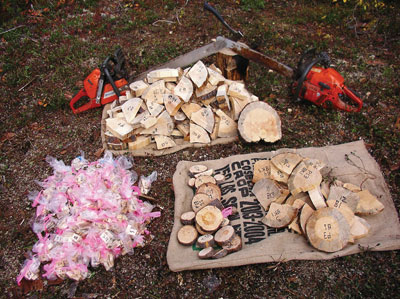 |
| (Photos: Dr. Kathy Lewis, University of Northern British Columbia) |
The 2008 update of the Mountain Pine Beetle Action Plan, released in
2002 by the BC Ministry of Forests and Range (BCMFR), estimates that
since the late 1990s, MPB has killed over 620 million cubic metres of
lodgepole pine. The affected area covers more than 130,000 square kilo-metres, about four times the size of Vancouver Island. By 2015, the
pest is expected to have killed 76% of the pine volume in the interior
of British Columbia and will have continued its march eastward.
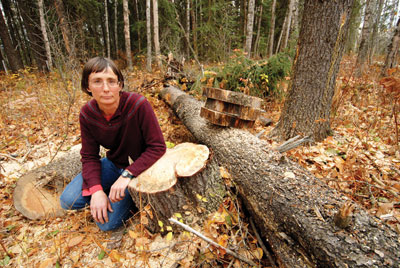 |
|
| Dr. Kathy Lewis, University of Northern British Columbia, samples mountain pine beetle-killed trees to determine the shelf life of affected trees.(Photos: Dr. Kathy Lewis, University of Northern British Columbia) | |
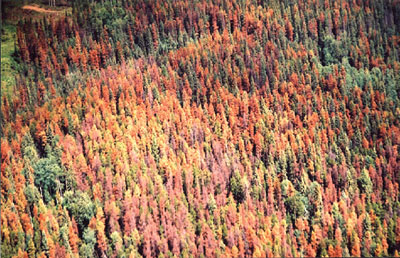 |
|
| The mountain pine beetle epidemic has decimated forests in central British Columbia and continues to spread. (Photo: British Columbia Ministry of Forests and Range) |
|
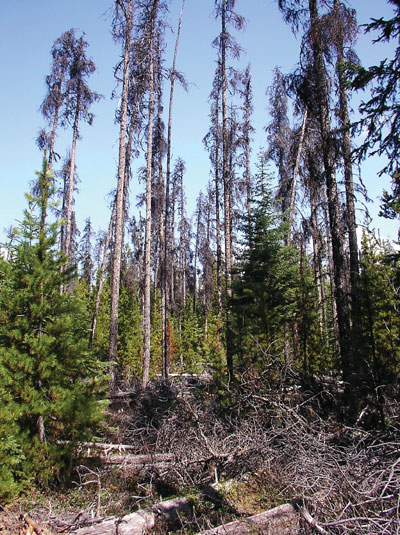 |
|
| Several years after dying, trees killed by the mountain pine beetle can become inaccessible for biomass harvest because of their susceptibility to falling, as well as understory regeneration. (Photo: Dr. Kathy Lewis, University of Northern British Columbia) |
|
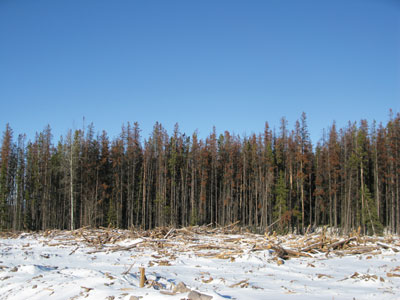 |
|
| (Photo: Tony Sauder, FPInnovations) |
|
 |
|
| (Photo: Pinnacle Pellet) Advertisement
|
There will be 400- to 500-million hectares of MPB-destroyed trees in
British Columbia available for harvest in the next 20 to 30 years,
assuming there’s no major fire or blow-down, says Don Gosnell, BCMFR
manager of bioenergy initiatives. But an abundance of dead trees
doesn’t necessarily spell success for bioenergy projects, in his
opinion. “The markets will determine whether the wood comes out or
not, for whatever reason,” Gosnell says. The beetle wood is declining
in quality, and trees are breaking off halfway up, he notes, leaving a
difficult and dangerous situation for those who want to come in and
clean up.
“Advanced regeneration is occurring in a lot of places,” Gosnell adds,
“and the government won’t let anyone come in because they’d damage that
undergrowth. Some stands are too remote or on terrain that is
unharvestable.” He says that, currently, there are tenure
opportunities of lower-quality stands of dead pine offered by the
province, and that the “reasonably healthy” pulp sector is using some
of that.
“To get investment for a bioenergy project,” Gosnell explains, “you
have to secure supply and prove you can truck it to your plant with
logistics that make sense.” Traditionally, that has taken the form of
residue from sawmills, many of which have shut down in recent years. For these reasons, most bioenergy projects that aim to use MPB-killed
wood do not use it exclusively as raw material.
Securing fibre supply continues to be a challenge for the developing
biomass energy sector, agrees Tony Sauder, forest feedstocks program
leader for FPInnovations, which has its head office in Pointe-Claire,
Quebec. “For areas of the BC interior where the MPB has had a
presence,” he says, “the long-term availability of roadside harvest
residues will decrease over the next five to ten years and will be
replaced by accumulations at satellite merchandising yards and the
harvesting of dead, standing timber to allow reforestation to proceed. This means the general price for feedstocks will increase
significantly, as users must cover more transportation costs and more
development costs.”
There is a silver lining, however, in that the trees can still wait some time for harvest.
“The limiting factor for [usable] lifespan is the fall-down rate of the
trees,” says Dr. Kathy Lewis, professor of ecosystem science and
management at the University of Northern British Columbia (UNBC) in
Prince George. Lewis’ research shows that standing MPB-killed trees up
to six months dead possess greenwood characteristics. Between two and
eight years after death, the wood shows “stable properties,” and most
trees are still standing. Starting around the eight-year mark,
however, they begin to fall in large numbers because of rot and
woodborer infestations at the base. Once a tree falls, rapid
deterioration ensues because the entire trunk is in contact with the
ground, says Lewis. Moist soil can lead to rapid fall-down because it
helps keep the wood moist and ripe for decay fungi, but drier sites can
also provide high fall-down rates because they support enhanced
carpenter ant activity.
Another silver lining can be found in the fact that companies are
ready, willing, and able to dive into bioenergy. “The existing forest
industry has long experience with handling wood fibre from the forest
and is well positioned to work with energy companies to supply biomass
for new processes,” says Sauder. “The existing Canadian pulp industry
[also] has infrastructure for generating electricity from biomass.” For example, Canfor Pulp Limited Partnership has cogeneration plants at
its three BC pulp mills. Electricity generation at its Prince George
and Intercontinental mills is being expanded incrementally, and
opportunities for further expansion are being investigated at the
Northwood facility.
Strategic Alliances
At Pinnacle Pellet Prince George, most of the feedstock is beetle
wood. “Generally up until about a year ago,” says chief operations
officer Leroy Reitsma, “we exclusively used mill byproduct fibre. However, since the economic downturn, mill production has decreased
while at the same time, the degradation of MPB-killed trees has
increased significantly, so we’re moving into the forest and cleaning
up the materials left behind, which are not merchantable for lumber
production.”
There is definitely enough fibre out there, in Reitsma’s opinion, if
you’re smart about it. “The key principle we’ve always adhered to is
to work with sawmills that are leaders in the industry,” he says. “For
example, we’ve worked together with Canadian Forest Products (Canfor)
and the Moricetown Native Band in Houston, British Columbia, to benefit
everyone in building a pellet plant as partners beside the Canfor
sawmill in 2006. The sawmill has realized an increased revenue stream
from its byproducts, and the partnership receives steady access to raw
materials.”
Abbotsford-based Biomass Secure Power is another company using a
partner strategy. It has an agreement with Lower Nicola Indian Band to
begin construction in early 2010 on a 12-MW biomass cogeneration and
pellet plant in Merritt. President and CEO Jim Carroll says that the
plant will use only beetle wood sourced from local mill residue and specifically cut under tender.
Another strategic alliance – this one between Western Biomass Power
Corporation of Prince George and the Tsilhqot’in National Government –
will submit a Phase II proposal to BC Hydro’s Bioenergy Call for
Power. If accepted, a $260-million, 60-MW generating plant (with some
heat also produced) using mostly beetle wood will be built in the
Cariboo Chilcotin region.
Western Biomass’ manager of business development, Jeff Paquin, says,
“The Tsilhqot’in National Government recently bought an idle sawmill
that shut down about a year ago, which employed mostly First Nations
people, and Western Biomass bought the land next to it. This project,
if accepted, will mean that the sawmill’s financial viability will
greatly improve and thereby sustain traditional sawmill jobs while
creating new bioenergy employment.” The cost of forest management
planning, harvesting, and reforestation will be shared between the two
operations, and both partners will share electricity profits. Western
Biomass is also submitting a proposal for a 30-MW plant with Gitxan
First Nations in the Hazelton area.
The BC government instituted the Bioenergy Call for Power as part of
its efforts to become electrically self-sufficient by 2016. Phase I,
conducted in 2008, resulted in four electricity purchase agreements
from projects headed by Canfor Pulp and PG Interior Waste to Energy in
Prince George, Domtar Pulp and Paper Products in Kamloops, and
Zellstoff Celgar Limited Partnership (Mercer International) in
Castlegar. Building on Phase I, Phase II is calling for both
larger-scale and community-level proposals that involve sources such as
underused forest-based biomass and wood waste sourced from new forest
tenure.
Other Bioenergy Projects
Here is a roundup of other projects, some well established and some
new. Capital Power (formerly EPCOR), based in Edmonton, Alberta, runs
the largest biomass electricity plant in North America. Built in 1993
in Williams Lake, it produces 68 MW from both mill residuals and
logging waste.
A wood gasification system with 15-million-BTU output will be
operational at UNBC by the end of 2010. It will deliver
high-temperature hot water to the existing water heating system. In
addition, UNBC has selected Nexterra Systems to supply and install a
turnkey biomass gasification system that will displace up to 85% of the
natural gas currently used to heat campus buildings. It will also
serve as an anchor for the new Northern Bioenergy Innovation Centre. Construction began in June 2009 and will be complete by mid-2010. Nexterra has also installed biomass gasification systems at the Kruger
tissue mill in New Westminster and at the Tolco plywood mill near
Kamloops, and has other projects on the go.
The city of Quesnel, through its Community and Economic Development
Corporation (QCEDC), is gathering funding with its partners for an
innovative cogeneration project with an anticipated completion date of
mid-2012. “The system would likely be a first in North America,” says
QCEDC executive director Jim Savage. The heat from the existing local
sawmill wood burner (used to heat kilns) will be recovered to produce
up to 2 MW of electricity – about half Quesnel’s current residential
consumption. A projected 5.5 MW of waste heat will be used to heat
large community buildings.
At its demonstration plant in McBride, Alterna Biocarbon of Prince
George is using Van Aardt process pyrolysis-based technology to
transform biomass feedstock into a variety of carbon-based energy
products.
FPInnovations (Feric Division) has completed a number of studies to
evaluate systems for grinding MPB-killed wood. For example, they’ve
analyzed the use of a track-mounted horizontal grinder to comminute
roadside residues in the BC southern interior for Domtar’s pulp mill at
Kamloops.
Pacific Bioenergy’s pellet plant in Prince George is using a
significant amount of beetle wood from logging slash and sawmill
residuals.
Western Biomass’s Paquin believes bioenergy’s future in British
Columbia is very bright in terms of the new research, training,
employment, and investment it is creating. “In other words,” he says,
“there is a silver lining to the MPB infestation, and the opportunity
is resulting in the full and complete use of wood fibre, with long-term
forest management plans being developed by industry and First Nations
alike.”
Print this page